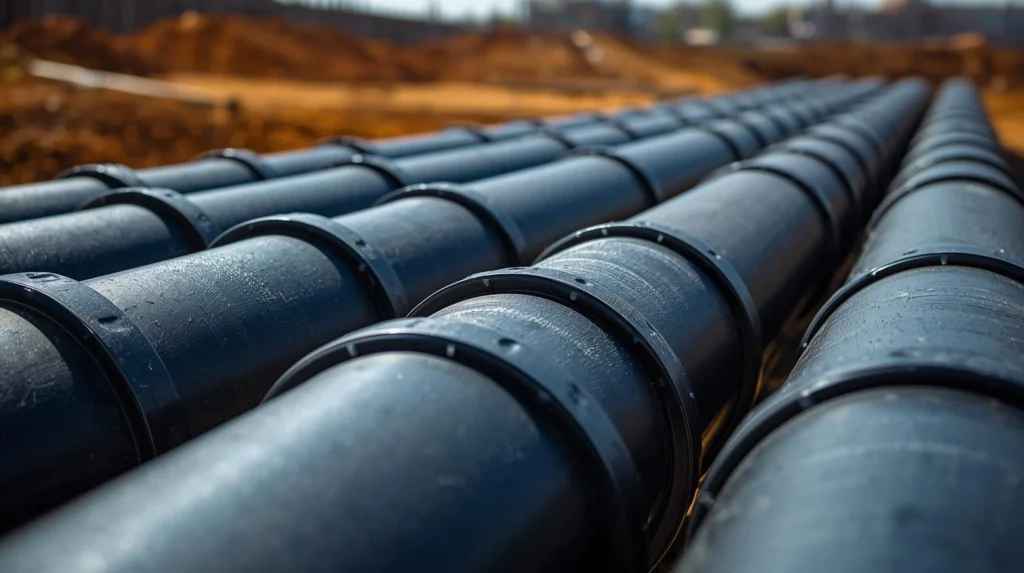The Rising Need for Sustainable Water Systems
Have you ever wondered how we can build water systems that are not only cost-effective but also environmentally sustainable? With the increasing global demand for fresh water and the urgent need to combat climate change, sustainable water infrastructure is more important than ever.
One of the most innovative solutions to this challenge is the use of HDPE pipes (High-Density Polyethylene pipes). These pipes are revolutionizing water systems around the world by offering a durable, cost-efficient, and eco-friendly alternative to traditional materials like PVC and steel.
In this post, we’ll dive into the top 5 benefits of using HDPE pipes for sustainable water infrastructure. Whether you’re an engineer, a business owner, or a policymaker, understanding these advantages will help you make informed decisions for future-proofing your water systems.
1. Unmatched Durability: The Key to Long-Lasting Water Systems
When it comes to water infrastructure, durability is non-negotiable. Traditional pipes can easily degrade over time, especially in harsh environments. This leads to costly repairs and replacements. HDPE pipes are renowned for their exceptional resistance to environmental factors such as corrosion, chemicals, and extreme temperatures.
Why HDPE Pipes Stand Out:
- Corrosion Resistance: Unlike metal pipes that rust over time, HDPE pipes do not corrode. This makes them ideal for both fresh and wastewater systems.
- Chemical Resistance: HDPE is highly resistant to a wide range of chemicals, ensuring the integrity of your water supply system over its lifetime.
- Impact Resistance: HDPE pipes can withstand significant impacts, making them suitable for areas prone to natural disasters or heavy traffic.
In practical terms, this means that HDPE pipes can last for decades, reducing maintenance costs and ensuring a reliable water supply for communities.
2. Eco-Friendly and Sustainable Choice
As the world becomes more focused on sustainability, it’s crucial to choose materials that minimize environmental impact. HDPE pipes are made from recycled materials and are fully recyclable themselves, making them a green choice for water infrastructure.
Environmental Benefits:
- Recyclable Material: HDPE is one of the most recycled plastics globally. At the end of their lifecycle, these pipes can be repurposed, reducing waste.
- Energy-Efficient Production: The manufacturing process for HDPE pipes uses less energy compared to other materials, resulting in a lower carbon footprint.
- Reduction in Water Loss: Thanks to their smooth inner surface, HDPE pipes have a low friction coefficient, which reduces water loss and improves the efficiency of the water distribution system.
By choosing HDPE pipes, you’re not only investing in infrastructure but also contributing to a more sustainable future.
3. Cost-Effective and Efficient Installation
Cost is always a primary concern when developing water infrastructure. HDPE pipes offer significant savings in both installation and maintenance, making them an ideal choice for long-term projects.
Cost Savings Include:
- Lower Installation Costs: HDPE pipes are lighter than steel or concrete alternatives, which reduces labor and transportation costs. Their flexibility also allows for easier handling and installation in various environments.
- Minimal Maintenance: The durability and resistance to corrosion reduce the need for frequent repairs, leading to substantial savings over the life of the system.
- Long-Term Value: Despite a slightly higher upfront cost, the long lifespan and low maintenance requirements of HDPE pipes result in a lower total cost of ownership.
Real-world example: In large-scale projects like the New York City Water Tunnel No. 3, the use of HDPE pipes has significantly reduced installation time and labor costs.
4. Flexibility and Versatility for Various Applications
Another standout feature of HDPE pipes is their versatility. They can be used in a wide range of applications, from underground water systems to stormwater drainage. Their adaptability makes them a go-to solution for various infrastructure needs.
How HDPE Pipes Provide Flexibility:
- Seamless Joints: HDPE pipes can be heat-fused together, creating a continuous, leak-proof system. This fusion eliminates the need for mechanical joints, reducing the chances of leaks and maintenance issues.
- Variety of Sizes: HDPE pipes are available in a variety of diameters and wall thicknesses, making them suitable for both large-scale and small-scale applications.
- Resilience in Difficult Conditions: HDPE pipes can be installed in areas with challenging geological conditions, including regions with seismic activity or permafrost.
One example of this versatility is the use of HDPE pipes in California’s water systems, where they are used to transport both potable and wastewater efficiently across varied terrains.
5. Improved Safety and Reliability
When it comes to water infrastructure, safety is paramount. HDPE pipes contribute significantly to the safety and reliability of water systems, thanks to their robust design and resistance to failure.
Safety and Reliability Features:
- Leak-Free System: Since HDPE pipes are welded at the joints, they provide a completely leak-free system, reducing the risk of contamination and water loss.
- Long-Term Reliability: The resistance to corrosion and chemical reactions ensures that these pipes remain safe and effective for decades without compromising water quality.
- Safe for Drinking Water: HDPE pipes are non-toxic and approved for use in potable water systems, ensuring safe water delivery to homes and businesses.
A relevant case study includes Australia’s water infrastructure projects, where HDPE pipes have been used for over 30 years without any significant issues, proving their reliability.
Conclusion: Embracing the Future of Water Infrastructure
The use of HDPE pipes in sustainable water infrastructure offers numerous advantages, from durability and cost-effectiveness to environmental benefits and improved safety. As the world moves toward more sustainable and resilient water systems, HDPE pipes stand out as a key player in achieving these goals.
By choosing HDPE pipes for your water systems, you’re not only making a smart investment for the present but also contributing to a greener, more sustainable future. Whether you’re involved in municipal projects or looking for efficient solutions for your business, HDPE pipes provide the reliability and efficiency needed to keep the world’s water infrastructure flowing smoothly.
FAQ Section
1. What makes HDPE pipes more durable than other pipe materials?
HDPE pipes are highly resistant to corrosion, chemicals, and physical impacts, making them far more durable than traditional materials like steel or concrete.
2. Are HDPE pipes eco-friendly?
Yes, HDPE pipes are made from recyclable materials and can be recycled again after use, making them an eco-friendly choice for sustainable water systems.
3. How do HDPE pipes reduce installation costs?
HDPE pipes are lightweight, easy to transport, and require less labor to install, significantly reducing both time and costs compared to other materials.
4. Can HDPE pipes be used for both potable and wastewater systems?
Absolutely. HDPE pipes are approved for use in both potable water and wastewater systems, making them a versatile option for various applications.
5. How long do HDPE pipes last?
HDPE pipes have an impressive lifespan of over 50 years, thanks to their resistance to corrosion, chemicals, and physical wear.


